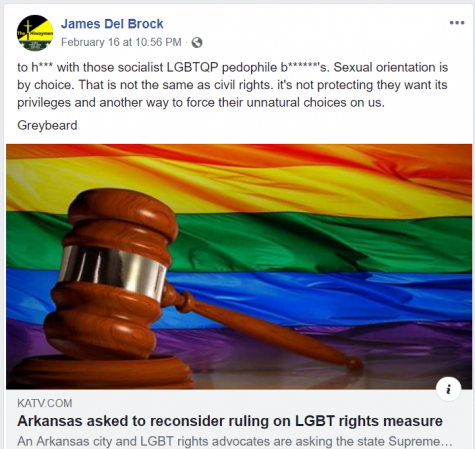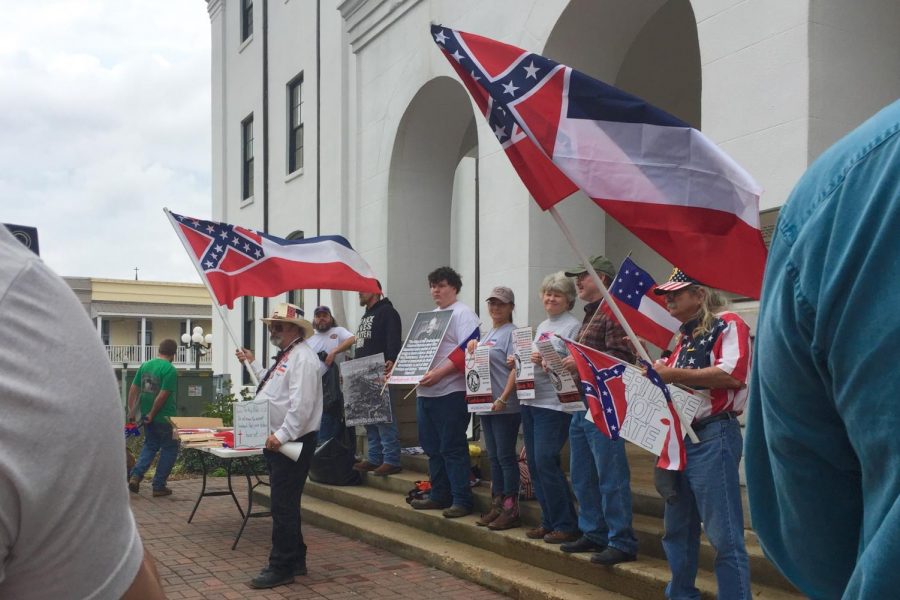Reece: I Went to a Neo-Confederate Rally
February 25, 2019
Most of us would like to believe that the winds of change have swept through Mississippi like the gusts created by a mighty storm, that people have come to the realization that we are all created equal. However, this is far from true. On Saturday, February 23, I drove to Oxford, Mississippi, to the campus of the University of Mississippi. I didn’t go for a college tour and I didn’t go to see a sporting event. I went to attend a Neo-Confederate Rally held by actual neo-Confederates.
The air in Oxford was in a perpetual drag. Days of torrential rain left Oxford and the surrounding areas covered in oceans of water and a boil water notice went into effect just hours before Confederate protestors rallied in the heart of Oxford. It seemed as if the town was on the brink of collapse, but then the stars and bars rode into town.
Neo-Confederates gathered behind the courthouse on the Square, Oxford’s famous tourist destination. Behind the courthouse lies a memorial to an unnamed Confederate soldier, one of many Confederate statues throughout the United States. In the last few years, these memorials have become hotbeds for the infamous “heritage vs. hate” discussion. Some argue that Confederate emblems such as the Confederate battle flag and the aforementioned Confederate statues represent a racist and hateful background while others tie it to their family and cultural heritage.
Mississippi, perhaps, has had the most complicated history with its Confederate heritage, especially its flagship university. For one, Mississippi is the last state in the country to still feature the Confederate battle flag. The University of Mississippi decided to remove the flag from its campus in 2016 following the Charleston shooting of an African American church by a white supremacist that left nine peaceful churchgoers dead. The perpetrator was a proud supporter of the controversial Confederate battle flag. Ole Miss also removed its mascot, Colonel Reb, in 2003, and stopped the playing of “From Dixie With Love” in 2009 and “Dixie” in 2016 at university sporting events.
In 2018, a student group, Students Against Social Injustice (SASI), called for the removal of Confederate monuments from the university. Flash to 2019 where two neo-Confederate groups, Confederate 901 and the Hiwaymen, decided that they were “fed up with this Political Correctness BS” and organized Saturday’s Mississippi Stands rally. Neither Confederate 901 nor the Hiwaymen are stationed in Mississippi, with 901 located in Memphis and the Hiwaymen operating out of Arkansas.
At around 1:30 p.m., approximately 90 neo-Confederates assembled on the courthouse grounds, leaving a small median located in a traffic circle decorated with flowers separating protestors, counter-protestors and bystanders. The Confederates dawned branded Hiwaymen shirts, hoodies with a “Redneck Lives Matter” slogan, and a sea of Mississippi and Confederate flags, including the infamous battle flag and even the official flag of the Confederate States of America. Across the street, counter-protestors carried signs reading things such as “A Heritage of Hate is Nothing to Celebrate.” There, a non-violent war of words ensued.
(For clarity, when I refer to protestors, I am referring to the neo-Confederates.)
“This statue ain’t going nowhere and we ain’t going nowhere,” yelled a particular defiant female Confederate. Ironically, she then yells “We are the silent majority,” a chant made famous by President Trump.
The counter-protesters called for the Confederates to go home, to which the protestors replied “Y’all need to go home! Y’all are the racists!”
K-Rack Johnson was one of the organizers of the Mississippi Stands event. “We’ve lost so much at the university already: the mascot, the fight song, the contextualization of historical buildings and markings on campus, taking the state flag down,” said Johnson. “They keep wanting more, wanting more, wanting more. It’s like a little two-year-old that’s addicted to candy.
“When is it ever going to stop? We are here to see if we can try to make it stop and to let these kids know that we are not going to be pushed around. We will be down here in the drop of a hat if anybody tries to do anything to that statue or monument.”
Johnson subscribes to the belief that Confederate monuments such as the one on the Square represent his heritage. “It represents my ancestors,” Johnson said. “It represents all the dead Confederate soldiers that are buried out in these trenches all throughout this country that don’t even have a marking for where they are buried.”
“That is for closure,” Johnson claimed. “That monument is for the families that didn’t have their members come back from war. That’s what that monument’s for, for those families to have somewhere to go so they can have remembrance.”
Johnson also wanted to work towards removing the stigma that supporters of the state flag are inherently racist. “We hope to change that narrative,” Johnson said. “We are people too. We deserve to accepted just like the LGBT community wants to be accepted. Just like any other ethnicity wants to be accepted. We want to be accepted too.”
James “General Greybeard” Brock, co-founder of the Hiwaymen, was also in attendance. Brock insisted that reporters look into the Corwin Amendment, a proposed amendment to the U.S. Constitution backed by northern politicians that would limit the federal government from federally abolishing slavery.
“Look at how the Southern states turned it down,” said Brock. “That’s a big show that it was not about racism or white supremacy, it was more about states’ rights. It was introduced to make slavery legal in all the states if the South would have signed back up with the Union at the time, and the South said ‘No, that’s not what we are fighting for. We are fighting for our rights. We are tired of being oppressed by a government making us go poor while the states up north are getting rich.’”
The Corwin Amendment was introduced as a last-ditch effort to stop the impending Civil War, but it was not going to legalize slavery in the United States as Brock claims. In fact, the Corwin amendment never mentioned slavery by name, instead choosing to refer to slaves as “person held to service.” The amendment was not going to force Northern states to legalize slavery, but instead to keep the institution of slavery legal in the South.
Additionally, the Southern states did not ratify the amendment because they did believe that it would not change their frustrations pertaining to slaves seeking refuge in Northern states and being allowed to escape their enslavement. The Corwin Amendment still left enough room so that abolitionist could halt the expansion of slavery, which was Abraham Lincoln’s primary goal. The South didn’t refuse to ratify the Corwin Amendment because it was racist, they seemingly refused to ratify it because it wasn’t racist enough.

James Del Brock appears to be defending the LGBT+ community from being used by the government for the “communist agenda,” but here he refers to the community as pedophiles along with other homophobic comments.
Brock also used the old excuse that the Civil War was not about slavery, and while yes, slavery was not the only reason that the Civil War happened, it is the most prominent. When one argues that the War was about states’ rights, they are neglecting the fact that the South was fighting for the right to label people as property. The Civil War was about also about the economy, or rather the perpetuation of a Southern economy that was built on the backs of slaves. It is a gross oversimplification to say that the Civil War was solely about slavery, but it is a gross misrepresentation to say that slavery wasn’t the leading factor.
Brock claimed that the North was making the South poor leading up to the Civil War. This is inherently incorrect, and as the National Park Service claims, cotton, the leading crop in the South, had its prices hit an all-time high on the eve of the war. The South only became poor after the war when its primary workforce was freed from their bondage.
Brock also spoke on the “communist and socialist takeover of America” by the U.S. government. “The demoralization of America, the forcing of the government to be the family caretaker instead of the mother and father, they have destroyed the role of marriage,” Brock said. “I do believe that a lot of it has to do with the using of Islam and the LGBT community, and I hate to say that they use them to divide the country in order to push the communist agenda.”
It is important to notice that while Brock is speaking against the U.S. government, he is wearing a “Make America Great Again” ball cap, a term coined by the leader of the U.S. government.
A look at Brock’s Facebook page reveals that he has had a history of prejudices against followers of Islam and the LGBT+ community. Brock once called Islam a “satanic cult” and refers to the LGBT+ community as the LGBTQP, with P standing for pedophiles. He also unironically calls for the removal of a statue depicting a historical socialist figure.

James Del Brock calls for the removal of a statue depicting a prominent socialist historical figure while claiming that the removal of other statues is wrong.
Furthermore, Brock claims that their agenda is different from the agenda of other racists, but goes on to say that racism “was a dead subject up until a few years ago, and we need to get back to that.”
The assertion that racism was a dead subject is frankly absurd, and the call to just sweep it under the mat is appalling. Racism has always existed in America, and to say that it was seemingly gone a few years ago shows how disconnected Brock is from the current state of America.
Maddison Colston, a bystander and sociology major from Oklahoma City, was not surprised by Saturday’s events. “Normally in Oxford, we have a bubble,” Colston said. “We don’t get a lot of this, or at least not as much, but I don’t think they are super convincing. I don’t think that this makes people think that we should keep them.”
The rally was not the only event happening in Oxford, as a collegiate basketball game pitting Ole Miss against the University of Georgia took place. Nevertheless, the effects of the rally trickled into the game, and eight Ole Miss basketball players knelt during the national anthem in protest. This comes as a shock, as the new Ole Miss basketball coach had previously stated that he would not allow players to kneel during the national anthem.
At a press conference following their victory over Georgia, Head Coach Kermit Davis said that he was not aware of the protest. “This was all about the hate groups that came to our community,” Davis said. “It’s created a lot of tension. I think our players made an emotional decision. We respect our player’s decision to do that.”
One of the most vocal counter-protestors was Kate Gluckman, a Cleveland resident and Executive Director for the Sunflower County Freedom Project, a nonprofit after-school program that helps Delta area kids prepare for college.
“We send a lot of students to the university,” said Gluckman. “Our students are scared to be on campus today because of the presence of this group and the rhetoric and speech that they are promoting.”
I felt that it was my duty and my responsibility and my privilege to come here and say that this is not what we represent here in Mississippi, this is not what we believe, and to encourage our state to remove the Confederate statues and to start dealing with our history.”
“They are not Mississippians and they do not represent the direction our state is going, and they need to go home,” Gluckman said.
“I do not think its right to celebrate that history,” Gluckman said. “I think it is to be remembered and learned from, but not celebrated. They belong in museums. I think there are examples of preserving history and learning history that remembers it but does not celebrate it.”
I suggest listening to Odetta’s performance of “This Little Light of Mine.” At one point in the rally, protestors began singing “I Wish I Was in Dixieland,” and the counter-protestors answered with the rebellious hymn of “This Little Light of Mine.” Once the Confederates joined in the hymn to mock them, the counter-protestors sang louder, making their light shine brighter than those who represented the hate they were fighting against.
This article is not about the heritage versus hate background of the flag. You could argue that the flag or any other Confederate symbolism represents cultural heritage and not a hateful ideology all day long, but when a group such as these come together to push a message of blatant hate in our state, to support an ideology that sought to keep people held against their will, people from both sides of the argument must come together and proclaim that we have moved past this. To say in 2019 that you are a proud Confederate has nothing to do with heritage but everything to do with hate, and the views expressed by some of the members support that.
The Civil War was a blight on American history, and while that history should not be erased or forgotten, it should also not be celebrated. The Civil War is the great teacher of American history, the beginning of the long road to a society built on justice and equality, not hate and prejudice. The war is a beacon of hope in the eyes of tyranny, our little light that will shine for shore to shore. We have to believe that one day, those winds of change will sweep through Mississippi. One day, racism and bigotry will find itself without a voice as society grows to accept that it has no place in America. The only thing stronger than hate and fear is love and hope, and as a sign outside of The Lyric on the Square proudly stated, “All you need is love.”









